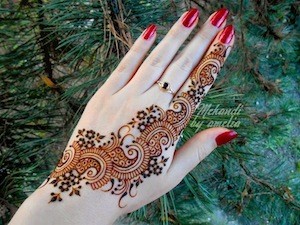An outer space-themed ketubah designed by thisisnotaketubah.com.
Judging from its ritual text, the ketubah (marriage contract) that is read aloud during a Jewish wedding ceremony isn’t the most exciting, romantic or joyous document. It spells out a husband’s fundamental Jewish legal obligations to his wife – food, clothing, conjugal rights – and guarantees the sum that the husband will pay his wife in the event of a divorce. Yet, increasingly, today’s ketubah designs are anything but dry and transactional. Going beyond placing a plain document in a basic picture frame, or using common designs such as a view of Jerusalem or the kabbalistic Tree of Life, ketubah artists and consumers alike are developing more elaborate and personalized tastes.
Morgan Friedman, chairman and “lead muse” of thisisnotaketubah.com, calls his initiative “the first company to do outlandish ketubot,” starting in 2011. Friedman said he “wanted a ketubah with super-crazy modern art” leading up to his wedding in 2010, but couldn’t find one. He approached his wife-to-be’s friend, Argentine artist Yael Magenheim, and she designed a ketubah to match his wedding, whose theme was the colour orange. Today, Magenheim is the artistic director for thisisnotaketubah.com, which has created 3,000 ketubot to date. Most customers order designs that the website already offers, but Friedman has a separate site, bespokeketubah.com, featuring commissioned artworks.
“My official reaction and what I tell [customers] is, ‘Whatever makes you happy.’ What makes the world a wonderful place is that different people have different preferences,” Buenos Aires-based Friedman told JNS.org, reflecting on some unique ketubot he has designed, such as one commissioned for a dragon-loving couple who are Game of Thrones fans.
Adriana Saipe was also inspired to enter the ketubah art business through the process of designing her own ketubah, in 2013. For customized ketubot – which make up 20% of her business on inkwithintent.com, the rest coming from existing designs – the Vermont-based artist said she often starts “with a place that has significance” for the couple. She asks them questions like where they met, where they’re living and where they’ve traveled together. For instance, one ketubah the artist is currently working on features landscapes from Miami, Pittsburgh and Providence, three cities where the couple has lived.
Saipe also hides “little secrets” in her designs. In a ketubah for a couple that enjoys rowing, she added boathouses along a river amid a nighttime Philadelphia cityscape; the average observer might not notice the small boathouses, but they are there for the couple to appreciate, Saipe explained, describing this design choice as the difference between the “outer layer that’s art on the wall” and the “inner story for the couple.”
Although Friedman cites 2011 as the advent of the “outlandish” ketubah, other artists estimate that elaborate, unique or customized ketubot were popularized at least two decades ago.
“The current trend to have modern art ketubahs began around the end of the 1990s,” said San Antonio-based artist Nishima Kaplan, who runs artketubah.com. “I was one of the first few artists to be involved in this trend, which was customer-driven. In the 1990s, the technology didn’t allow for just-in-time ketubah prints, so people who wanted an artistic piece with a unique text had to commission a handmade piece. I made a lot of these in the early 2000s. Now, there is such a wide selection of artistic designs on the internet that can be ordered with any text, so there is less demand for handmade pieces that are artistic but not personal, the unique designs that reflect a couple’s life continue to be desired.”
Jerusalem-based artist Danny Azoulay took up ketubah design nearly 20 years ago, when Israel’s tourism minister asked him to design award certificates for companies slated to be named as the top 50 businesses for tourism in the Jewish state. At least 10 people who saw examples of the certificates in Azoulay’s store commented that they would make for compelling ketubot, prompting the artist to pursue that niche.
Azoulay, who runs ketubahazoulayart.com, recalled that, when he first began designing ketubot, most Judaica production took place in China and India, where manufacturing costs are lower than they are in Israel. He understood that he couldn’t compete with sellers of standard mass-produced Judaica items, and needed a niche such as the ketubah. Simultaneously, more customers were asking him to produce commissioned ketubot.
Saipe, who has produced about 1,000 ketubot, said that, based on her conversations with consumers of various ages, the trend of elaborate designs began “somewhere between the 1980s and 2000.”
“There’s a really interesting dichotomy among ketubah artists themselves,” she said, noting that, on the one hand, there are “well-established” artists who produce ketubot with a classic old-world feel, and, on the other hand, there has been the emergence during the last five years of “contemporary” artists who employ “modern symbolism and modern times” in their designs.
What’s the reason behind the trend? The artists agree that customized ketubot are simply indicative of the popularity of personalized art in general, in addition to reflecting the personalization of various aspects of weddings.
“Everyone loves personalized art. This is not a new thing,” said Kaplan, who has created more than 3,000 ketubot since 1998. That said, some couples’ desire to alter and personalize the ketubah’s age-old Aramaic ritual text may also play a role in the trend of commissioned designs, she said.
“Once a couple begins thinking about a text they want that is different from the traditional one on their parents’ ketubah, it may be a natural next step to wanting an art ketubah,” said Kaplan.
Read more at jns.org.






